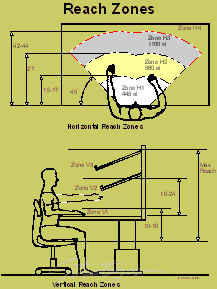Determining
Locations
After
Sort and Shine, "Set" determines
and identifies the location of each item. The methods for
determining such locations may be elementary and intuitive or formal
and elaborate.
Often
the elementary methods work quite well,
especially during in the early phases. Workers simply look at each
item, visualize its use, estimate the frequency of use and then
select a location. After a few days, they can review and revise
their locations. Locations
should be identified at both a micro and sub-micro level.
String
diagrams can assist at the micro-level. Principles
of Ergonomics can assist at the sub-micro level. Horizontal and
vertical reach zones help to
determine the best sub-micro location. The heaviest and most
frequently used items should be in the nearest reach zones.
Once
people develop awareness, their
body sense will alert them to excessive reaching, walking or awkward
positions. They learn to "SET"
items instinctively.
 Reach Zones Reach Zones
Reach zones help to establish optimum location for tools and parts. Lower zones are reachable
quicker and with less strain on joints and muscles. Reserve these lower zones for the most frequently used items.
String Diagrams
String diagrams can assist at the micro-level. Principles
of Ergonomics can assist at the sub-micro level. Horizontal and
vertical reach zones help to determine the best sub-micro location. The
heaviest and most frequently used items should be in the nearest reach
zones.
Once people develop awareness, their body sense will alert them to
excessive reaching, walking or awkward positions. They learn to "SET"
items instinctively.
|





